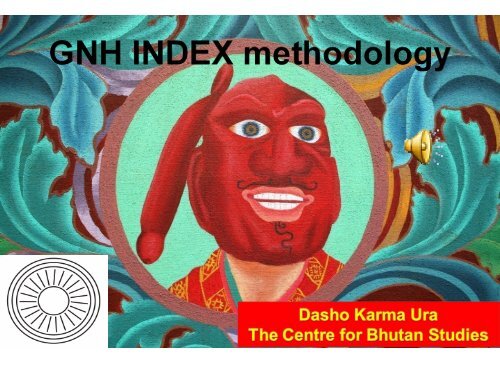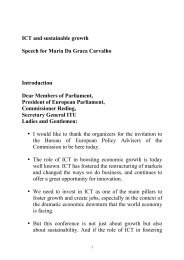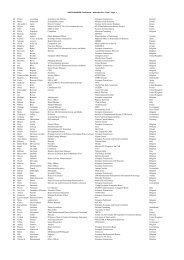Dasho Karma Ura - PARADISO
Dasho Karma Ura - PARADISO
Dasho Karma Ura - PARADISO
- No tags were found...
You also want an ePaper? Increase the reach of your titles
YUMPU automatically turns print PDFs into web optimized ePapers that Google loves.
LONG TERM ACTIONS: TO ACHIEVE HARMONY OF EXISTENCE• Promote successful birth, living, aging and dying• Reorganise structure of government from present servicedelivery system to GNH focused organisationaldevelopment.• Balance national consciousness between externalsensation based stimuli and internal contemplation basedstimuli• Stabilize material affluence level to balance economy andecology• Restore purity of air, light, noise, water and soil• Regenerate community and social life• Protect biodiversity• Influence the world to change, and be changed by goodinfluences
MEDIUM TERM ACTIONS: TO ENTRENCH GNH INFLUENCE• Formulate fiscal system in harmony with GNH(budget allocation, tax and non-tax penaltysystem)• Introduce full-cost national accounting andfootprint analysis to complement GDP accounts• Influence curriculum and media towards GNH• Influence OD and HR towards GNH• Influence transportation, industrial, financial andagriculture systems towards GNH
SHORT TERM ACTIONS: TO MOBILIZE CONSCIENCE• Fix GNH indicators for baseline and targets• Create budgets and programmes to achievethose targets• Provide ongoing commentary on currentissues from GNH perspective• Disseminate GNH to promote unity of purpose• Educate people on GNH for behaviouralchange: hold conferences, produce multi-lingual films
Why we need new indicators• How to make the case togovernment officials,international agencies,conventional economists,donors• From Statement of Principle(GNH>GDP) to Practicality, Policiesand Programmes7
National GoalSINGLE NUMBER GNH INDEXSectoralProgressMeasurementInfluenceGNH INDICATORSInfluencePolicy MakingBUDGET ALLOCATION FORMULAGNH POLICY SCREENING TOOLSProjectFormulationGNH PROJECT SELECTION TOOLS
Relationships among Domains/Variables: A Holistic View =Interdependence Example Only Arrow: cause-effect relationship“-” sign: negative effectTwo lines: delay
INDICATORS = Value OF societyMost indicators are about market economyChange in indicators is a first steptowards changing or reflecting new values13
% contribution of weighted domains to GNH Index
Weighted GNH Index at domain level = .80Time Use 0.970Health 0.855Community Vitality 0.838Psychological Wellbeing 0.772Education 0.548Good Governance 0.880Culture 0.852Living Standards 0.814Ecology 0.713
DZONGKHAG RANKING BY unweigthed GNH INDEX = .80Haa 0.8273Tsirang 0.8185Samdrup Jongkhar 0.8142Tashigang 0.8112Samtse 0.8062Thimphu 0.8030Zhemgang 0.8216Wangdue Phodrang 0.8173Pemagatshel 0.8138Tashi Yangste 0.8106Gasa 0.8032Dagana 0.8026
Unweighted GNH INDEX BY GENDER .81=Male 0.825 Female 0.796
Objective and Subjective IndicatorsSubjectiveObjectiveGoodBadGoodTrue Progress NeurosisBad FalseConsciousnessMiseryAlex Michelos – University of British Columbia22
Relationships among Domains/Variables: A Deductive View
Psychological Wellbeing Index•Mental Health Indicators•Spirituality Indicators•Emotional Balance Indicators
Emotional balance indexPositive emotions• Compassion• Calmness• GenerosityNegative emotions• Frustration• Selfishness• Jealousy
Time Use Index• Total working hours per day 7 hours• Sleep hours indicators 8 hours
• Work activities1. Crop farming and kitchengardening (agric)2. Business, trade andservices3. Care of children and sickmembers of household4. Construction and repairs5. Craft related activities6. Forestry and horticulturalactivities7. Household maintenance8. Livestock related activities9. Processing of food anddrinks10. Quarrying work• Non-work activities1. Communityparticipation2. Education andlearning3. Personal care4. Religious activities5. Social and culturalactivities6. Sports and leisure7. Travel/commute8. Waiting
Community Vitality Index•Community trust indicators•Social support indicators•Reciprocity indicators•Socialization indicators•Family indicators•Kinship indicators•Safety indicators
Health Index•Self reported health indicator•Body Mass Index•# of Healthy days in a month•Long term disability indicator•Health knowledge indicators•Health barrier indicators
20,69716,566 BMI= weight(KG)/height (m 2 ) Under weight—BMI =30.091,937
Culture Index•Dialect indicators•Traditional recreational indicators•Artisan skill indicators•Value transmission indicators•Community festival indicators•Reciprocity indicators•Basic Precept indicators
Education Index•Dzongkha language indicators•Historical literacy indicators•Literacy and education indicators
Ecology Index•Environmentaldegradation indicators•Ecological knowledgeindicators•Afforestation indicators
Good Governance Index•Government performanceindicators•Freedom indicators•Institutional trust indicators
Living Standard IndexHousehold Income indicators(absolute & relative)Food security indicatorHousing indicators (room ratio +ownership)Hardship indicators
Household maintenance bygenderActivitiesDifference in frequencyMaleFemaleCooking 192 402Dish washing 37 199House cleaning 84 182Laundry 25 84Shopping 21 21Other householdactivities 172 218Difference in timeMale Female1:23 1:500:25 0:360:55 0:461:02 1:221:25 1:480:29 0:32AverageTime1:410:340:171:171:370:304242
ExampleSurvey question:How safe do you feel from human harm at night?Rarely safe Usually safe Always safe1 2 3Rarely safe Usually safe Always safeInsufficientSufficient1 1 0
Step 1. Apply sufficiency cutoff to obtaininsufficiency headcountsMatrix A:CompassionMeditationHealthydays Socialization RightsVoluntarydaysIncome EnmityFoodsecurityPerson11 3 30 4 3 4 3 1 2Person21 2 30 3 3 10 2 2 2Person31 2 24 3 3 50 2 2 1Person41 3 30 4 3 10 2 2 2CompassionMeditationHealthydays Socialization RightsVoluntarydaysIncome EnmityFoodsecuritySufficiency cutoff 1 3 30 4 3 4 3 1 2
Matrix A:Person1Person2Person3Person4CompassionMeditationHealthydays Socialization RightsVoluntarydaysIncome EnmityFoodsecurity1 3 30 4 3 4 3 1 21 2 30 3 3 10 2 2 21 2 24 3 3 50 2 2 11 3 30 4 3 10 2 2 2MatrixB:Person1Person2Person3Person4CompassionMeditationHealthydays Socialization RightsVoluntarydaysIncome EnmityFoodsecurity1 0 0 0 0 1 0 1 01 1 0 0 0 1 0 0 01 1 1 0 0 0 0 0 11 0 0 0 0 1 0 0 0
Matrix B:Person1Person2Person3Person4CompassionMeditationHealthydays Socialization RightsVoluntarydays Income EnmityFoodsecurity1 0 0 0 0 1 0 1 01 1 0 0 0 1 0 0 01 1 1 0 0 0 0 0 11 0 0 0 0 1 0 0 0Insufficiency headcounts (HI)= Number of insufficiencies / Total number ofrespondentsHICompassionMeditationHealthydays Socialization RightsVoluntarydays Income EnmityFoodsecurity4/4 2/4 1/4 0 0 3/4 0 1/4 1/4GNH Sufficiency Index = 1- Average Insufficiencyheadcounts (HI)= 1 - (4/4+2/4+1/4+0+0+3/4+0+1/4+1/4)/9
Step 2. Calculation of distance from cutoff(Sufficiency cutoff – actual) ÷ (Sufficiency cutoff - minimum)Rarely safe Usually safe Always safe1 2 3InsufficientSufficient1 1 01 .5 0100% negative score 50% negative score Perfectly positivescoreIf respondent reports “usually safe”(3 – 2) ÷ (3-1) = 0.5
Matrix C:CompassionMeditationHealthydays Socialization RightsVoluntarydays Income EnmityFoodsecurityPerson1 1 0 0 0 0 0.64 0 1 0Person2 1 0.50 0 0 0 0.09 0 0 0Person3 1 0.50 0.08 0 0 0 0 0 1Person4 1 0 0 0 0 0.09 0 0 0Distance from cutoff= (Sufficiency cutoff – actual) ÷ (Sufficiency cutoff - minimum)HICompassionMeditationHealthydays Socialization RightsVoluntarydays Income EnmityFoodsecurity4/4 ¼ .08/4 0 0 .82/4 0 1/4 1/4GNH Breadth + Depth Measure = 1- Average distance from cutoff= 1 - (4/4+1/4+.08/4+0+0+.82/4+0+1/4+1/4)/9=.88
Step 4. Squaring the distance from cutoffMatrix C:SpiritualityMatrix D:SelfreportedhealthstatusHealthydaysAttendingcommunityfestivalsRightsVoluntarydays Income EnmityPerceptionpollutionof riversPerson1 1 0 0 0 0 0.64 0 1 0Person2 1 0.50 0 0 0 0.09 0 0 0Person3 1 0.50 0.08 0 0 0 0 0 1Person4 1 0 0 0 0 0.09 0 0 0Person1Person2Person3Person4SpiritualitySelfreportedhealthstatusHealthydaysAttendingcommunityfestivalsRightsVoluntarydays Income EnmityPerceptionon pollutionof rivers1 0 0 0 0 0.40 0 1 01 0.25 0 0 0 0.01 0 0 01 0.25 0.01 0 0 0 0 0 11 0 0 0 0 0.01 0 0 0
Step 4. Computing GNH Index (Breadth + Depth + Inequality Measure)Matrix D:SpiritualitySelfreportedhealthstatusHealthydaysAttendingcommunityfestivalsRightsVoluntarydays Income EnmityPerceptionon pollutionof riversPerson1 1 0 0 0 0 0.40 0 1 0Person2 1 0.25 0 0 0 0.01 0 0 0Person3 1 0.25 0.01 0 0 0 0 0 1Person4 1 0 0 0 0 0.01 0 0 0Average squared distance from the cutoffHICompassionMeditationHealthydays Socialization RightsVoluntarydays Income EnmityGNH Index (Breadth+Depth+ Inequality Measure)= 1- Average squared distance from thecutoff= 1-(1+.5/4+.01/4+.42/4+1/4+1/4)/9= .81Foodsecurity4/4 .5/4 .01/4 0 0 .42/4 0 1/4 1/4






